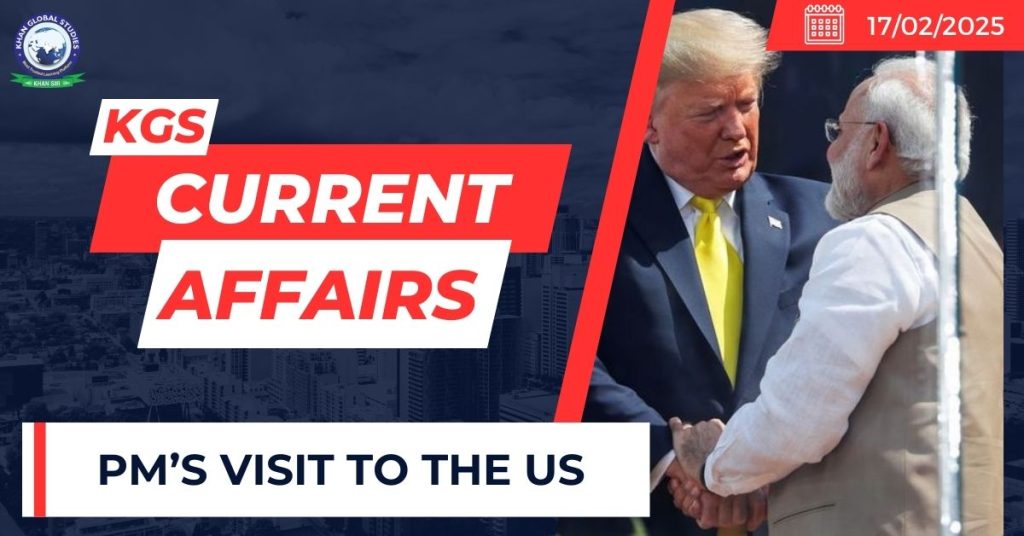Context:
Recently, the Prime Minister of India held a bilateral meeting with the U.S. President at the white house, marking the Indian PM’s first visit since the election of the U.S. president.
Key Outcomes of the Meeting
During the visit, both leaders reaffirmed the strong partnerships between the U.S. and India, focusing on shared values such as freedom, the rule of law, and human rights.
They also exchanged perspectives on current global developments of mutual interest.
They launched a new initiative called the “US India COMPACT for the 21st Century” Initiative: To drive significant change in key areas of cooperation, both countries committed to a results-focused plan with tangible outcomes this year, showcasing the trust in their mutually beneficial partnership.
Defence Sector Initiatives:
- The U.S. and India plan to sign a new ten-year “Framework for the U.S.-India Major Defense Partnership in the 21st Century” this year.
- Both countries will work on procuring and co-producing “Javelin” Anti-Tank Guided Missiles and “Stryker” Infantry Combat Vehicles in India to meet defence needs quickly.
- A new initiative, the Autonomous Systems Industry Alliance (ASIA), will be launched to promote industry partnerships and production in the Indo-Pacific.
- The leaders also welcomed the upcoming “Tiger Triumph” tri-service exercise, which will be hosted in India with a larger scale and complexity.
Trade and investment initiatives:
- A bold goal called “Mission 500” was set to more than double bilateral trade to $500 billion by 2030.
- To achieve this, they plan to negotiate the first part of a mutually beneficial Bilateral Trade Agreement (BTA) by fall 2025.
Energy Security initiatives:
- Both reaffirmed their commitment to the U.S.-India Energy Security Partnership, covering oil, gas, and civil nuclear energy.
- The U.S. expressed strong support for India’s full membership in the International Energy Agency (IEA).
- The leaders promised to fully implement the U.S.-India 123 Civil Nuclear Agreement, including building U.S.-designed nuclear reactors in India through large-scale localization and possible technology transfer.
Technology and innovation initiatives:
- The leaders launched the U.S.-India TRUST initiative (“Transforming the Relationship Utilizing Strategic Technology”) to encourage collaboration between governments to government, academia, and the private sector in fields like defence, AI, semiconductors, quantum, biotechnology, and space.
- They also launched the INDUS Innovation program, modelled after the successful INDUS-X platform, to promote the U.S.-India industry and academic partnerships, with investments in space, energy, and emerging technologies.
- The leaders hailed 2025 as a pioneering year for U.S.-India civil space cooperation, with plans for a NASA-ISRO effort through AXIOM to bring the first Indian astronaut to the International Space Station (ISS), and early launch of the joint “NISAR” mission, the first of its kind to systematically map changes to the Earth’s surface using dual radars.
Multilateral cooperation initiatives:
- As Quad partners, they emphasized the importance of ASEAN’s central role, adherence to international law, and good governance.
- They launched the Indian Ocean Strategic Venture, a new forum to boost economic connectivity and commerce in the Indian Ocean region.
- The leaders reaffirmed their commitment to fighting terrorism and against groups like Al-Qa’ida, ISIS, Jaish-e-Mohammad, and Lashkar-e-Tayyiba.
People to People cooperation initiatives:
- Both agreed to enhance academic collaborations, including joint or dual degree programs, setting up joint Centers of Excellence, and creating offshore campuses of U.S. universities in India.
- Both are committed to improving law enforcement cooperation to fight illegal immigration, organized crime, and trafficking networks, including drugs, arms, and human trafficking.

